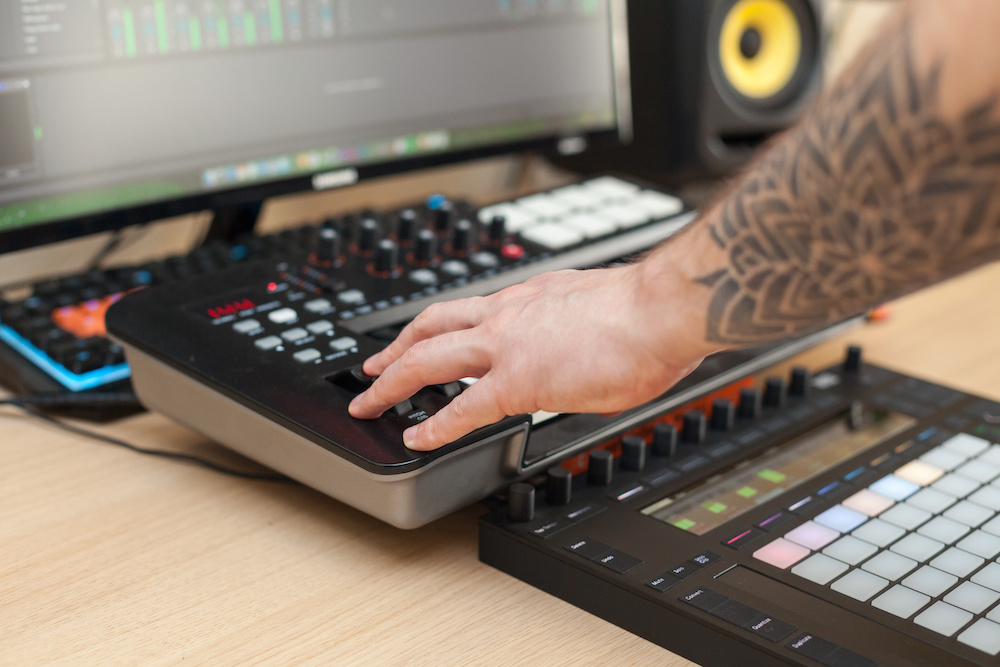How To Edit MIDI Files and Create Better Sounds
We may earn a commission for purchases using our links. As an Amazon Associate, we earn from qualifying purchases.
Before the dawn of computers and the internet, we only knew how to make music using musical instruments and natural implements.
We combined sounds from nature with rhythm and melodies, and we recorded music using rudimentary equipment.
When computers emerged, music creation has become more accessible.
Today, computers and midi keyboards enable us to work with music through the use of MIDI files.
If you know how to edit MIDI files, you can create better sounds just as if you had control over many musical instruments.
What Is a MIDI File?
MIDI stands for Musical Instrument Digital Interface.
A MIDI file contains the instructions for which notes to play and when, how long, or how loud they should be played.
A MIDI file will either have the “.MID” or “.MIDI” file extension.
Since it only contains audio instructions, it is much lighter than WAV files or MP3 files.
Additionally, a MIDI file will allow you to tweak, replace, or manage every discernible component within the file.
How To Edit MIDI Files
If you want to learn how to modify MIDI files, you will need to understand three things: where to edit MIDI files, where to get them, and which ones to choose.
MIDI Editors
Editing a MIDI file is like editing a digital word document. You will need a computer and the appropriate software to alter the contents of the file.
MIDI editors are also similar to word document editors. Some are open-source and free, while others require a subscription or a fixed fee.
Unlike free word document editors, however, free MIDI editors provide everything you need to alter a MIDI file to your liking.
The internet is so diluted with top-grade free MIDI editors that you might even end up trying out several applications to find what suits you best.
If you have some cash to spare or think a monthly subscription can better fulfill your requirements, there are also top paid apps for MIDI editing.
These apps have something to offer that even the best free apps cannot.
For example, paid apps have more user-friendly digital interfaces, as well as tools and parameters that make editing a breeze.
To start, go for the free software and then work your way up to paid apps if your MIDI-editing practice becomes profitable.
Types of MIDI Editors
On another note, you will find MIDI editors in three standard interface variations: score view, piano-roll view, or a combination of both.
Typically, since the free apps cost nothing, they run the simpler, more straightforward piano-roll view.
Paid applications offer the score view platform, which is a much more technical approach to editing MIDI files.
Some paid apps let you switch between score view and piano-roll view.
Piano-Roll View
An application using piano-roll view uses the traditional piano rolls, a continuous spreadsheet containing all the notes of a musical piece.
A digital spreadsheet continuously runs until you hit Stop or Pause in piano-roll view, and each musical note plays its cycle as it passes through a tracker bar.
The piano-roll view allows you to paste and trim segments of musical pieces so that you can create entirely new tracks from existing MIDI files.
Score View
A MIDI editor using the score view has a vast array of musical staff containing individual musical notes and notations.
Instead of altering musical segments in different tracks, you can adjust the parameters of each musical note to create an entirely different sound.

Where To Get MIDI Files
The internet is an open source for a plethora of MIDI files.
However, to edit and play around with the most popular MIDI files available on the internet, you will have to gain access to them, some of which come with a price.
There are also online sources for royalty-free MIDI files. All you have to do is browse online for unlimited resources.
Some of the most popular search results include BitMidi, MidisFree and FreeMidi.
Which MIDI Files To Choose
While some MIDI files only have a few tracks within them, high-quality MIDI files have separate music tracks for each type of musical instrument or sound component.
Some MIDI file sources can make your life easier by listing all the specific components of each MIDI file.
However, other sources will not have much in the description, and you will have to download the file only to find out that it is missing the tracks you need.
More often than not, you will find two MIDI files containing the same music but with varying track contents.
If you choose the file with more tracks, you will probably have better editing capabilities.
MIDI Editing
With all the variations in the available MIDI editors, you will first have to decide whether you want to work in piano-roll view or score view.
If you choose the latter, be prepared to purchase the best applicable software.
Otherwise, you can proceed with the easiest method of copying, cutting, and relocating musical segments across different tracks in piano-roll view.
There is no universal step-by-step process in editing any particular MIDI file, but you can consider the following steps:
Step 1: To start editing a MIDI file, run your choice of MIDI editor software.
Step 2: Import the MIDI file into the MIDI editor.
Step 3: Choose the adjustments you want to make.
Some of the things you can do should include removing instruments, changing notes, shifting the pitch, inserting and deleting segments, and creating your own tunes.
Every MIDI editor may have unique controls for each of these alterations.
Step 4: Keep a backup copy of your MIDI files.
If you want to work efficiently and avoid re-downloading your MIDI files, it is always good practice to keep backup copies.
Step 5: While making alterations, always remember to save your work regularly.
It pays to secure hours of work by ensuring you have a saved file.
Conclusion
You can only learn how to edit MIDI files by familiarizing yourself with the available commands, controls, and features in your choice of MIDI editor.
It doesn’t require learning a programming language, and it is not even rocket science.
All you have to do is stay interested in creating music and new sounds.
Most MIDI editors have hours and hours of tutorials available on the internet, and you will find that the techniques are pretty simple.

